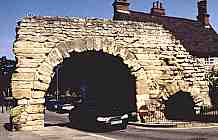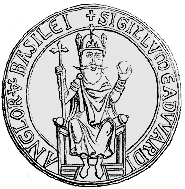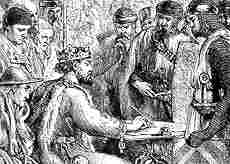



If you are looking at this page without frames, there is more information about medieval writing to be found by going to the home page (framed) or the site map (no frames).
| Law and Administration (2) | ||||||
| In England we are looking at a society in which the literate engines of law and government of the Roman era had been thoroughly lost and abandoned. Under the early Anglo-Saxons it was essentially a tribal society. The population was tiny, rural and organised under local leaders in a manner that is not fully understood, but which probably had an ethnic dimension relating to the area of origin of the immigrants. Bede hints as much, even if his neat classifications of Angles, Saxons and Jutes was a simplification of the situation. Social ordering through oral customary law and verbal councils of aristocrats or elders does not necessarily result in chaos. Ask any anthropologist. The concept of, say, a major criminal act being argued and discussed in front of the village bigwigs and punished by some ceremonial act of restitution or a general festivity at the expense of the adjudged guilty party has worked in small scale societies in many parts of the world. It may seem foreign to our tradition of crime and punishment, but it need not be primitive or especially uncouth. |
 |
|||||
| The physical as well as the literate remains of Roman urban life disappeared in Britain. Newport Arch in Lincoln is one of the surviving fragments. | ||||||
 |
A schoolbook representation of Anglo-Saxon justice. Read the body language and think of some word associations to conjure up what was in the artist's mind: dramatic, individualised, barbaric, corrupt? The artist has depicted court process as theatre, of a rather melodramatic persuasion, rather than as a dispassionate application of the rules of justice. And all because they didn't write it down! | |||||
| While the Anglo-Saxon invasions may have had a fragmenting effect on the institutions of society, the subsequent Scandinavian raids and invasions served to consolidate the power of the aristocratic rulers at the top end of society. The arrival of that ultimate neo-Viking, William the Conqueror, sorted out a bunch of squabbling earls and their unpleasant families and set up a system in which the king held a range of ultimate powers, theoretically. Finding a means to assert those powers in practice accelerated the process of developing literate mechanisms for the management of society. | ||||||
 |
The earliest Anglo-Saxon charters were most likely penned in monastic scriptoria. There was no special charter hand of this period and the scripts employed were the insular minuscule and later Caroline minuscule used as book hands. There are even some early charters in uncial script, that precise and formal majuscule used for significant books like gospels. (See Lowe 1960) A royal chancery may have come into being at around the time of Edward the Confessor, who is also credited with the introduction of a significant material artifact of the written word in law and government, the great seal. | |||||
| The great seal of Edward the Confessor, or at least probably a reasonable impression of it. | ||||||
| The royal seal was a great lump of sealing wax impressed on both sides with a design which included both written words in the form of an inscription and an image signifiying the power of the king. It was not used to close up a letter, but was attached by strips to an open document as its ultimate authentication. It was an extension of the concept of use of an object as a testimony of good faith in a transaction. Show your charter from the king to any doubters and, even if they can't read, that impressive wax sculpture dangling off it will convince them that you have the real thing. Even with the words written on it, it is a form of non-verbal testimony. | ||||||
 |
The early post-Conquest kings were probably pretty illiterate and most likely could not write. It wasn't their job. They had other people to do that for them, just as they had other people to serve their dinner. However, after literacy became sufficiently widespread that even kings indulged in it, they did not sign their formal documents. King John did not sign Magna Carta, despite numerous schoolbook representations of him doing it. Authentication by object, not written word, remained the procedure for the most formal documents throughout the medieval period. A process born out of the tradition of oral testimony became part of the tradition of literate government and law. | |||||
| King John signs Magna Carta in a school textbook. We are giving the schoolbook view of history a hard time here. | ||||||
| In fact, we get to 1386 before we even know what the signature of an English king looked like. It is hardly an example of flowing calligraphy. | ||||||
| Signature of Richard II on a letter in the National Archives. | ||||||
| The language of charters and writs of the Norman period is also a clue to their origin in an oral tradition. Formal documents were written in Latin, but they could include long strings of terms in Old English. These terms represented rights and privileges, or obligations from which the grantees were being given exemption, and it might be argued that there was no equivalent Latin term for these words. However, medieval Latin evolved to encompass all sorts of concepts which were not covered by the Classical language. These legalistic terms often occur in pairs, sometimes alliterated and with a definite poetic rhythm to them. Try saying the following out aloud. | ||||||
| et saca et socne on strande et streame on wudu et felde, tolnes et teames | ||||||
| et grithbreces et hasocne et forestealles et infangenes thiofes et flemene fernithe | ||||||
| From a charter of Henry I to Christ Church, Canterbury (British Library, Campbell Charters xxi 6). By permission of the British Library. | ||||||
| Or try a similar example. | ||||||
| cum saca et soca et toll et team et infangentheof et flemenefyrmthe | ||||||
| et miskenninge et sceawinge | ||||||
| Also from a charter of Henry I, to the abbey of Westminster. (From New Palaeographical Society 1903) | ||||||
| With our current utter dependence on the written word for all important matters we have forgotten some special skills, techniques for committing things to oral memory. Those of us old enough last did this with our multiplication tables, but at one time there were people who could apply it to the laws of the land. Illiterate perhaps, but ignorant, no. | ||||||
|
|
||||||
|
|
||||||
|
If you are looking at this page without frames, there is more information about medieval writing to be found by going to the home page (framed) or the site map (no frames). |
||||||